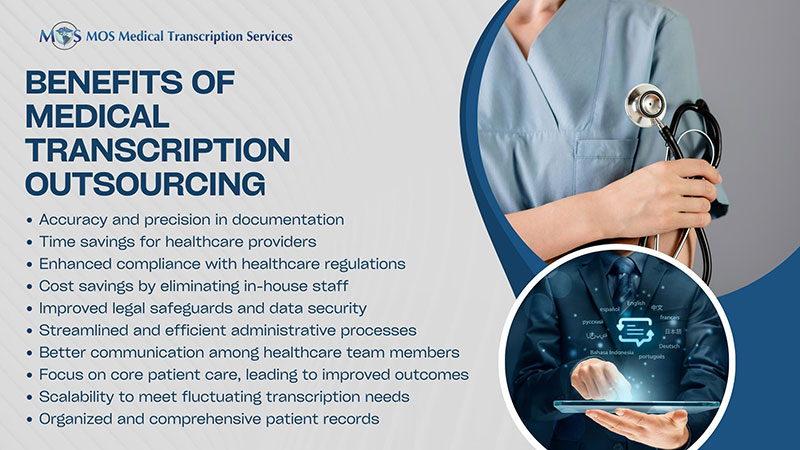
Complete and accurate medical documentation tells the patient’s story, and promotes effective and continuous care. Many providers outsource electronic health record (EHR) documentation tasks to a reliable medical transcription service organization to achieve these goals. Poor medical documentation can compromise patient safety, increase medico-legal risks, and impact physician reimbursement. Let’s take a look at what poor medical documentation means and how outsourcing medical transcription can help.
What Constitutes Poor Medical Documentation?
One of the key goals of electronic health records is to help providers ensure complete and accurate charting.
Drew K. Siegel, MD, CCDS, CPC, a CDI specialist at MedPartners HIM defines poor documentation as that which is lacking clarity, specificity, or completeness, and is of overall poor quality. Siegel points out that documentation quality depends on who is using a particular health record, and for what purpose. For physicians, poor documentation is that which impairs patient evaluation and/or treatment. For a coder, poor documentation would be that which lacks the sufficient specificity to assign accurate diagnosis and procedure codes(www.fortherecord.com).
Here are common errors that can lead to poor medical documentation:
- The physician’s message is not interpreted correctly: This can happen due to illegible handwriting in paper records or typos in transcription. For example, entering ‘Hyper’ instead of ‘Hypo’ or ‘Anorexia’ instead of ‘Anorexic’ in the record can have serious consequences for patient care, especially for a patient who comes to the emergency department in an unconscious state. Medication errors can occur with sound-alike medication names if the physician is speaking to the nurse over the phone. Wrong information in the chart would cause the patient to be treated for a wrong condition.
- Lacks specificity: If the documentation lacks specificity, it will not convey the patient’s whole story. It is essential to specify clearly what services were performed and the reasons for reporting specific diagnosis codes. For example, when documenting diabetes, the type of diabetes mellitus, the body system affected, and the complications affecting that body system must be correctly conveyed. Likewise, when documenting asthma, to ensure the highest level of specificity in diagnosis, the physician should specify the cause, severity (mild, moderate or severe), temporal factors (acute, chronic, intermittent, persistent, status asthmaticus, acute exacerbation). The care and treatment to support this specific condition should also be clearly documented.
- Incomplete documentation: Delinquent or incomplete medical records can have serious financial issues, hinder continuity of care, and also compromise patient safety. Unless the patient’s complete medical history is documented, the physician cannot make a correct diagnosis. Missing data can be due to not collecting information (e.g., patient was never asked about asthma) or a lack of documentation (e.g., patient was asked about asthma but the response was not entered in the medical record). Incomplete documentation can lead to misdiagnosis or delay in diagnosis. Other aspects of incomplete medical records include: records for services provided have not been fully recorded by the physician, records are insufficient to support services billed to insurance, incomplete progress notes, and unauthenticated or unsigned medical records.
- Incorrectly entered or misplaced data: Misplaced information is data entered into the wrong field in the EHR, such as, procedure notes in the progress note portion (AHIMA). Misplaced information can be frustrating and time consuming. In facilities that have not fully transitioned to EHRs, key information may remain on paper and other formats and go unnoticed. If lab work, radiology reports, and family histories are not fully documented in the EHR, providers may be working with incomplete information when they are seeing patients. AHIMA notes that misplaced or incorrect EHR documentation can also cause severe physical harm and even prove fatal.
- Copy-paste errors: The EHR copy-and-paste function is designed with the goal to simplify and save physicians’ time on documentation tasks. Sadly, its misuse is one of the reasons for poor medical documentation. The consequences of copy and paste include inaccurate or outdated information, difficulty in monitoring disease progression or resolution, inability to identify when the documentation was first created, propagation of erroneous information, and note bloat. Studies have found that physicians do a lot of data entry as well as “copy-pasting” during the patient encounter, which can lead to serious errors, negatively impact care, and increase risks of malpractice.
Other medical documentation errors include adding entries at a later time, documenting subjective data, not clarifying incomprehensible orders, using he wrong abbreviations, and entering information into the wrong patient chart.
Measures to Promote EHR Documentation Integrity
As there are several factors contributing to poor EHR documentation, healthcare providers should take steps to address all of them. The goal should be to ensure that documentation is:
- Accurate
- Complete
- Timely
- Factual
- Organized
- Compliant with industry and organization standards
Provider education is key to improve the integrity of medical charting. Physicians and nurses must be educated on the importance of using words to document to the highest level of specificity and fully documenting services provided.
While EHRs have improved legibility concerns, misuse of copy-and-paste is an issue that hinders original thinking. Providers should be alerted about this and encouraged to use the function correctly.
Other strategies that CDI specialists use to improve EHR documentation include reviewing patient medical records to find incomplete documentation of diagnoses, and querying the provider to resolve identified documentation issues.
Time is a major factor when it comes to making entries in the medical record. Nurses often document at the end of their shift and if they miss out on anything, it can effect patient care. Likewise, EHR data entry during the encounter can affect the time that physicians spend providing patient care. Timely entries are essential to ongoing care in order to reflect a clear record of what has happened.
How Outsourcing Medical Transcription Helps
Medical transcription outsourcing can go a long way in helping physicians maintain error-free, timely documentation.
- Medical transcriptionists are trained to convert physician dictation in clear, complete and accurate medical records. This will promote better care delivery.
- Certified medical transcriptionists also review and review and edit documents generated using speech recognition technology. Online medical transcription integrated with EHRs/EMRs can help physicians maintain a complete and integrated medical record system.
- With medical transcription services, physicians can focus on the patient rather than on EHR data entry.
- Medical transcriptionists can also reduce documentation errors that physicians can make when they type quickly. They will ensure that proper medical terms and appear in patient records and can even catch certain errors and query the physician to correct them.
- All information will be entered in the correct location in the EHR, so that notes are easily retrievable. Documents that are easy to understand and navigate can lead to increased referrals among physicians.
- Accurate documentation will support error-free coding for proper and timely reimbursement.
- Error-free documentation can reduce compliance and malpractice risks.
Even minor errors in medical documentation can have grave consequences. Taking steps to improve documentation is crucial for patient safety and wellbeing as well as for quality reporting and appropriate reimbursement.


